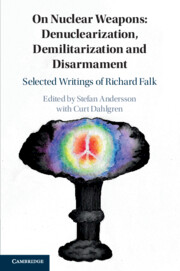 On Nuclear Weapons: Denuclearization, Demilitarization and Disarmament
On Nuclear Weapons: Denuclearization, Demilitarization and Disarmament Book contents
- On Nuclear Weapons: Essays by Richard Falk on Denuclearization, Demilitarization, and Disarmament
- On Nuclear Weapons: Essays by Richard Falk on Denuclearization, Demilitarization, and Disarmament
- Copyright page
- Dedication
- Epigraph
- Contents
- Foreword by Zia Mian
- Preface by Richard Falk
- Acknowledgments
- Part I International Law and World Order
- Part II Impacts of Democracy, Neutrality, and National Interest
- Part III Nuclear Policy Initiatives
- Contents
- 12 Arms Control, Foreign Policy, and Global Reform
- 13 The Illegitimacy of the Nonproliferation Regime
- 14 No First Use of Nuclear Weapons
- 15 Environmental Warfare and Ecocide
- Part IV Remembering the Past, Encountering the Future
- Index
15 - Environmental Warfare and Ecocide
Facts, Appraisal, and Proposals
from Part III - Nuclear Policy Initiatives
Published online by Cambridge University Press: 04 July 2019
- On Nuclear Weapons: Essays by Richard Falk on Denuclearization, Demilitarization, and Disarmament
- On Nuclear Weapons: Essays by Richard Falk on Denuclearization, Demilitarization, and Disarmament
- Copyright page
- Dedication
- Epigraph
- Contents
- Foreword by Zia Mian
- Preface by Richard Falk
- Acknowledgments
- Part I International Law and World Order
- Part II Impacts of Democracy, Neutrality, and National Interest
- Part III Nuclear Policy Initiatives
- Contents
- 12 Arms Control, Foreign Policy, and Global Reform
- 13 The Illegitimacy of the Nonproliferation Regime
- 14 No First Use of Nuclear Weapons
- 15 Environmental Warfare and Ecocide
- Part IV Remembering the Past, Encountering the Future
- Index
Summary
In Indochina during the past decade we have the first modern instance in which the environment has been selected as a “military” target appropriate for comprehensive and systematic destruction. Such an occurrence does not merely reflect the depravity of the high-technology sensibilities of the war-planners. It carries out the demonic logic of counterinsurgency warfare, especially when the insurgent threat is both formidable and set in a tropical locale. Recourse to deliberate forms of environmental warfare is part of the wider military conviction that the only way to defeat the insurgent is to deny him the cover, the food, and the life-support of the countryside. Under such conditions, bombers and artillery seek to disrupt all activity, and insurgent forces find it more difficult to mass for effective attack. Such policies have led in Indochina to the destruction of vast tracts of forest land and to so-called “crop-denial programs.” The US government has altered tactics in recent years, shifting from chemical herbicides to Rome plows as the principal means to strip away the protective cover of the natural landscape, but the basic rationale of separating the people from their land and its life-support characteristics persists.
- Type
- Chapter
- Information
- On Nuclear Weapons: Denuclearization, Demilitarization and DisarmamentSelected Writings of Richard Falk, pp. 264 - 290Publisher: Cambridge University PressPrint publication year: 2019
